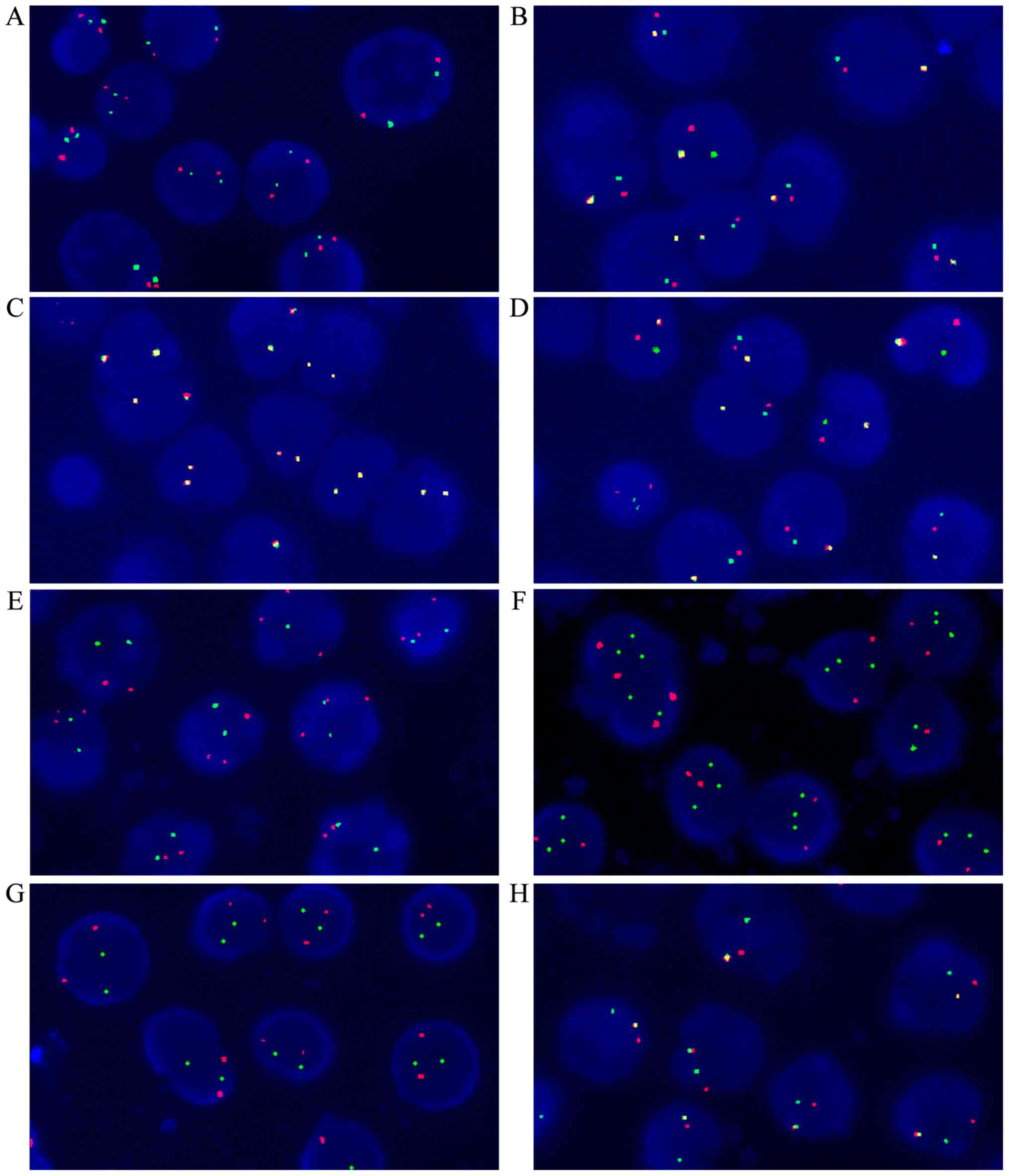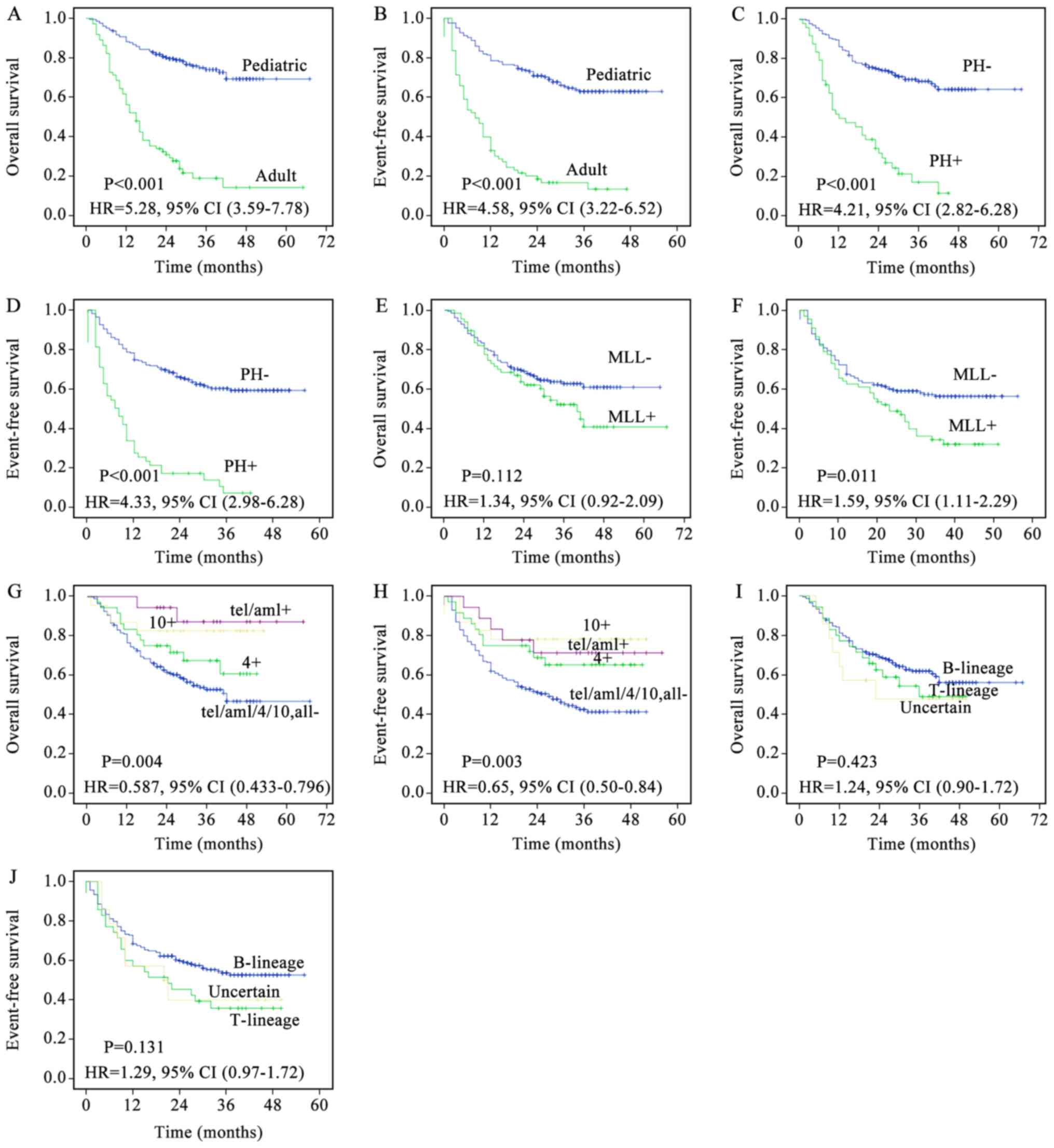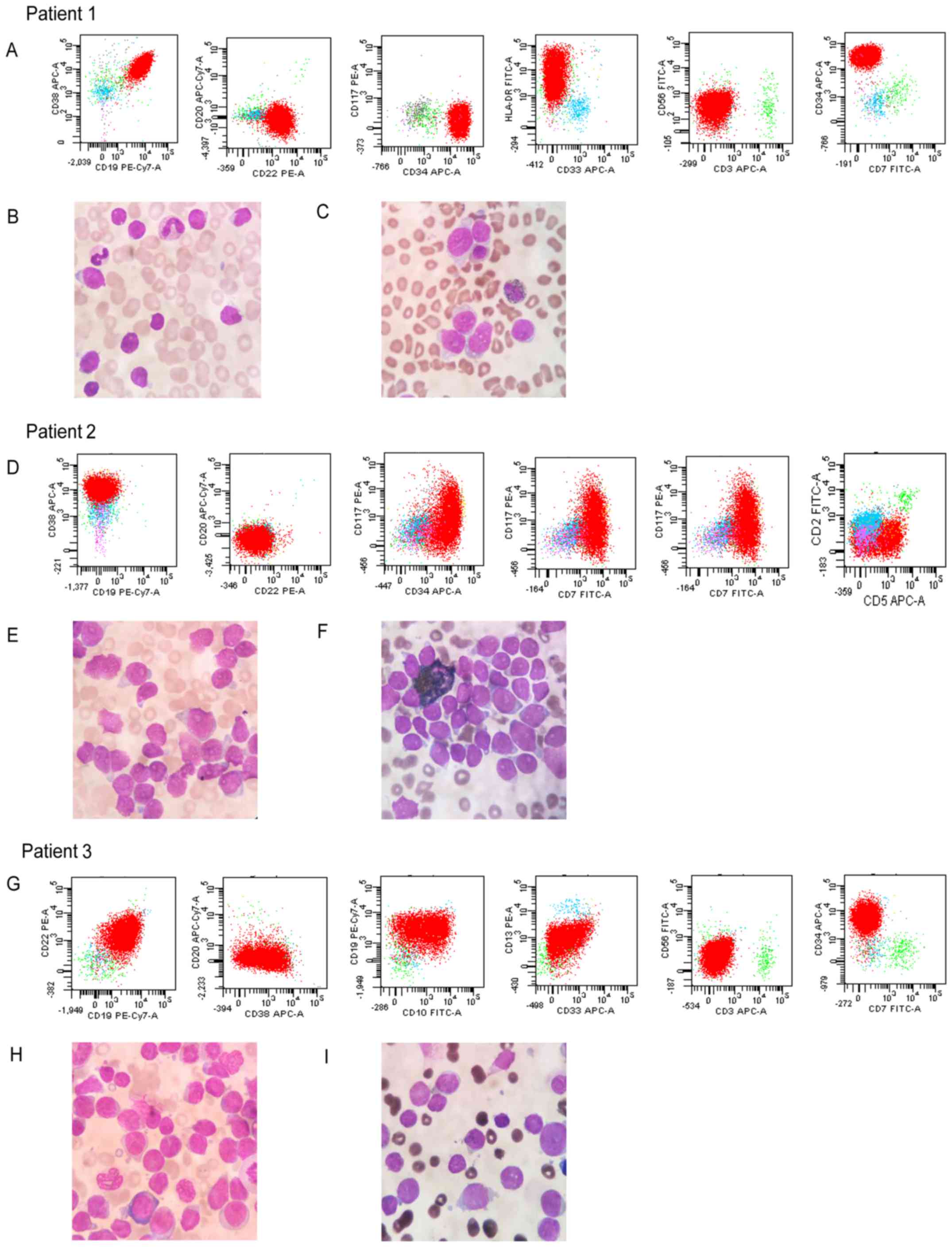|
1
|
Pui CH, Robison LL and Look AT: Acute
lymphoblastic leukaemia. Lancet. 371:1030–1043. 2008. View Article : Google Scholar : PubMed/NCBI
|
|
2
|
Siegel R, Naishadham D and Jemal A: Cancer
statistics, 2012. CA Cancer J Clin. 62:10–29. 2012. View Article : Google Scholar : PubMed/NCBI
|
|
3
|
Inaba H, Greaves M and Mullighan CG: Acute
lymphoblastic leukaemia. Lancet. 381:1943–1955. 2013. View Article : Google Scholar : PubMed/NCBI
|
|
4
|
Lafage-Pochitaloff M, Baranger L, Hunault
M, Cuccuini W, Lefebvre C, Bidet A, Tigaud I, Eclache V, Delabesse
E, Bilhou-Nabéra C, et al: Impact of cytogenetic abnormalities in
adults with Ph-negative B-cell precursor acute lymphoblastic
leukemia. Blood. 130:1832–1844. 2017. View Article : Google Scholar : PubMed/NCBI
|
|
5
|
Pui CH, Crist WM and Look AT: Biology and
clinical significance of cytogenetic abnormalities in childhood
acute lymphoblastic leukemia. Blood. 76:1449–1463. 1990.PubMed/NCBI
|
|
6
|
Faderl S, O'Brien S, Pui CH, Stock W,
Wetzler M, Hoelzer D and Kantarjian HM: Adult acute lymphoblastic
leukemia: Concepts and strategies. Cancer. 116:1165–1176. 2010.
View Article : Google Scholar : PubMed/NCBI
|
|
7
|
Aricò M, Schrappe M, Hunger SP, Carroll
WL, Conter V, Galimberti S, Manabe A, Saha V, Baruchel A,
Vettenranta K, et al: Clinical outcome of children with newly
diagnosed philadelphia chromosome-positive acute lymphoblastic
leukemia treated between 1995 and 2005. J Clin Oncol. 28:4755–4761.
2010. View Article : Google Scholar : PubMed/NCBI
|
|
8
|
Bassan R and Hoelzer D: Modern therapy of
acute lymphoblastic leukemia. J Clin Oncol. 29:532–543. 2011.
View Article : Google Scholar : PubMed/NCBI
|
|
9
|
Shen S, Cai J, Chen J, Xue H, Pan C, Gao
Y, Tang Y, Wang J, Li B, Wang X, et al: Long-term results of the
risk-stratified treatment of childhood acute lymphoblastic leukemia
in China. Hematol Oncol. 2018.(Epub ahead of print). View Article : Google Scholar
|
|
10
|
Möricke A, Reiter A, Zimmermann M, Gadner
H, Stanulla M, Dördelmann M, Löning L, Beier R, Ludwig WD, Ratei R,
et al: Risk-adjusted therapy of acute lymphoblastic leukemia can
decrease treatment burden and improve survival: Treatment results
of 2169 unselected pediatric and adolescent patients enrolled in
the trial ALL-BFM 95. Blood. 111:4477–4489. 2008. View Article : Google Scholar : PubMed/NCBI
|
|
11
|
Gökbuget N, Kneba M, Raff T, Trautmann H,
Bartram CR, Arnold R, Fietkau R, Freund M, Ganser A, Ludwig WD, et
al: Adult patients with acute lymphoblastic leukemia and molecular
failure display a poor prognosis and are candidates for stem cell
transplantation and targeted therapies. Blood. 120:1868–1876. 2012.
View Article : Google Scholar : PubMed/NCBI
|
|
12
|
Sive JI, Buck G, Fielding A, Lazarus HM,
Litzow MR, Luger S, Marks DI, McMillan A, Moorman AV, Richards SM,
et al: Outcomes in older adults with acute lymphoblastic leukaemia
(ALL): Results from the international MRC UKALL XII/ECOG2993 trial.
Br J Haematol. 157:463–471. 2012. View Article : Google Scholar : PubMed/NCBI
|
|
13
|
Hoelzer D, Walewski J, Dohner H, Viardot
A, Hiddemann W, Spiekermann K, Serve H, Dührsen U, Hüttmann A,
Thiel E, et al: Improved outcome of adult Burkitt lymphoma/leukemia
with rituximab and chemotherapy: Report of a large prospective
multicenter trial. Blood. 124:3870–3879. 2014. View Article : Google Scholar : PubMed/NCBI
|
|
14
|
Thomas DA, O'Brien S, Faderl S,
Garcia-Manero G, Ferrajoli A, Wierda W, Ravandi F, Verstovsek S,
Jorgensen JL, Bueso-Ramos C, et al: Chemoimmunotherapy with a
modified hyper-CVAD and rituximab regimen improves outcome in de
novo Philadelphia chromosome-negative precursor B-lineage acute
lymphoblastic leukemia. J Clin Oncol. 28:3880–3889. 2010.
View Article : Google Scholar : PubMed/NCBI
|
|
15
|
Hoelzer D, Bassan R, Dombret H, Fielding
A, Ribera JM and Buske C; ESMO Guidelines Committee, . Acute
lymphoblastic leukaemia in adult patients: ESMO clinical practice
guidelines for diagnosis, treatment and follow-up. Ann Oncol. 27
Suppl 5:v69–v82. 2016.PubMed/NCBI
|
|
16
|
Chiaretti S, Zini G and Bassan R:
Diagnosis and subclassification of acute lymphoblastic leukemia.
Mediterr J Hematol Infect Dis. 6:e20140732014. View Article : Google Scholar : PubMed/NCBI
|
|
17
|
Brown PA, Shah B, Fathi A, Wieduwilt M,
Advani A, Aoun P, Barta SK, Boyer MW, Bryan T, Burke PW, et al:
NCCN guidelines insights: Acute lymphoblastic leukemia, version
1.2017. J Natl Compr Canc Netw. 15:1091–1102. 2017. View Article : Google Scholar : PubMed/NCBI
|
|
18
|
Chen W, Zheng R, Baade PD, Zhang S, Zeng
H, Bray F, Jemal A, Yu XQ and He J: Cancer statistics in China,
2015. CA Cancer J Clin. 66:115–132. 2016. View Article : Google Scholar : PubMed/NCBI
|
|
19
|
Hunger SP and Mullighan CG: Acute
lymphoblastic leukemia in children. N Engl J Med. 373:1541–1552.
2015. View Article : Google Scholar : PubMed/NCBI
|
|
20
|
Szczepański T, Harrison CJ and van Dongen
JJ: Genetic aberrations in paediatric acute leukaemias and
implications for management of patients. Lancet Oncol. 11:880–889.
2010. View Article : Google Scholar : PubMed/NCBI
|
|
21
|
Chilton L, Buck G, Harrison C J,
Ketterling RP, Rowe JM, Tallman MS, Goldstone AH, Fielding AK and
Moorman AV: High hyperdiploidy among adolescents and adults with
acute lymphoblastic leukaemia (ALL): Cytogenetic features, clinical
characteristics and outcome. Leukemia. 28:1511–1518. 2014.
View Article : Google Scholar : PubMed/NCBI
|
|
22
|
Mazloumi SH, Madhumathi DS, Appaji L and
Prasannakumari: Combined study of cytogenetics and fluorescence
in situ hybridization (FISH) analysis in childhood acute
lymphoblastic leukemia (ALL) in a tertiary cancer centre in South
India. Asian Pac J Cancer Prev. 13:3825–3827. 2012. View Article : Google Scholar : PubMed/NCBI
|
|
23
|
Moorman AV: The clinical relevance of
chromosomal and genomic abnormalities in B-cell precursor acute
lymphoblastic leukaemia. Blood Rev. 26:123–135. 2012. View Article : Google Scholar : PubMed/NCBI
|
|
24
|
Cao P, Li Y, Li X, Zhang G and Chen F:
Detecting chromosomal aberrations in myelodysplastic syndrome with
fluorescence in situ hybridization and conventional cytogenetic
analysis. Zhong Nan Da Xue Xue Bao Yi Xue Ban. 39:605–611. 2014.(In
Chinese). PubMed/NCBI
|
|
25
|
Moorman AV, Harrison CJ, Buck GA, Richards
SM, Secker-Walker LM, Martineau M, Vance GH, Cherry AM, Higgins RR,
Fielding AK, et al: Karyotype is an independent prognostic factor
in adult acute lymphoblastic leukemia (ALL): Analysis of
cytogenetic data from patients treated on the Medical Research
Council (MRC) UKALLXII/Eastern cooperative oncology group (ECOG)
2993 trial. Blood. 109:3189–3197. 2007. View Article : Google Scholar : PubMed/NCBI
|
|
26
|
Landau H and Lamanna N: Clinical
manifestations and treatment of newly diagnosed acute lymphoblastic
leukemia in adults. Curr Hematol Malig Rep. 1:171–179. 2006.
View Article : Google Scholar : PubMed/NCBI
|
|
27
|
Druker BJ, Sawyers CL, Kantarjian H, Resta
DJ, Reese SF, Ford JM, Capdeville R and Talpaz M: Activity of a
specific inhibitor of the BCR-ABL tyrosine kinase in the blast
crisis of chronic myeloid leukemia and acute lymphoblastic leukemia
with the Philadelphia chromosome. N Engl J Med. 344:1038–1042.
2001. View Article : Google Scholar : PubMed/NCBI
|
|
28
|
Schrappe M, Hunger SP, Pui CH, Saha V,
Gaynon PS, Baruchel A, Conter V, Otten J, Ohara A, Versluys AB, et
al: Outcomes after induction failure in childhood acute
lymphoblastic leukemia. N Engl J Med. 366:1371–1381. 2012.
View Article : Google Scholar : PubMed/NCBI
|
|
29
|
Collins EC and Rabbitts TH: The
promiscuous MLL gene links chromosomal translocations to cellular
differentiation and tumour tropism. Trends Mol Med. 8:436–442.
2002. View Article : Google Scholar : PubMed/NCBI
|
|
30
|
Cayuela JM, Baruchel A, Orange C, Madani
A, Auclerc MF, Daniel MT, Schaison G and Sigaux F: TEL-AML1 fusion
RNA as a new target to detect minimal residual disease in pediatric
B-cell precursor acute lymphoblastic leukemia. Blood. 88:302–308.
1996.PubMed/NCBI
|
|
31
|
Sutcliffe MJ, Shuster JJ, Sather HN,
Camitta BM, Pullen J, Schultz KR, Borowitz MJ, Gaynon PS, Carroll
AJ and Heerema NA: High concordance from independent studies by the
Children's Cancer Group (CCG) and Pediatric Oncology Group (POG)
associating favorable prognosis with combined trisomies 4, 10, and
17 in children with NCI Standard-Risk B-precursor Acute
Lymphoblastic Leukemia: A Children's Oncology Group (COG)
initiative. Leukemia. 19:734–740. 2005. View Article : Google Scholar : PubMed/NCBI
|
|
32
|
Yeoh EJ, Ross ME, Shurtleff SA, Williams
WK, Patel D, Mahfouz R, Behm FG, Raimondi SC, Relling MV, Patel A,
et al: Classification, subtype discovery, and prediction of outcome
in pediatric acute lymphoblastic leukemia by gene expression
profiling. Cancer Cell. 1:133–143. 2002. View Article : Google Scholar : PubMed/NCBI
|
|
33
|
Conter V, Bartram CR, Valsecchi MG,
Schrauder A, Panzer-Grümayer R, Möricke A, Aricò M, Zimmermann M,
Mann G, De Rossi G, et al: Molecular response to treatment
redefines all prognostic factors in children and adolescents with
B-cell precursor acute lymphoblastic leukemia: Results in 3184
patients of the AIEOP-BFM ALL 2000 study. Blood. 115:3206–3214.
2010. View Article : Google Scholar : PubMed/NCBI
|
|
34
|
Zhao MY, Yu Y, Xie M, Yang MH, Zhu S, Yang
LC, Kang R, Tang DL, Zhao LL and Cao LZ: Digital gene expression
profiling analysis of childhood acute lymphoblastic leukemia. Mol
Med Rep. 13:4321–4328. 2016. View Article : Google Scholar : PubMed/NCBI
|
|
35
|
van Dongen JJ, van der Velden VH,
Brüggemann M and Orfao A: Minimal residual disease diagnostics in
acute lymphoblastic leukemia: Need for sensitive, fast, and
standardized technologies. Blood. 125:3996–4009. 2015. View Article : Google Scholar : PubMed/NCBI
|












